Andrew Hollingworth Frost, Biographical sketch.
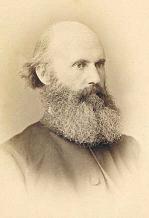 Andrew H. Frost (Hull 1819 - Cambridge 1907)
Andrew H. Frost (Hull 1819 - Cambridge 1907)
His portrait in 1870,
from the Church Mission Society archives
- 1819: Born in Hull, York (England), April 26th. Son of Charles Frost, solicitor
and antiquary. Brother of Percival Frost born in 1817.
- 1838: Admitted Pensioner at St
John's College, Cambridge, founded in 1511, one of the colleges of the
University of Cambridge. Pensioner is the second of three ranks in which
students were matriculated, the other ranks being Fellow-commoner and Sizar.
- 1842: B.A., Bachelor of Arts 11th Wrangler.
- 1844: Appointed Mathematical Master in the Manchester
Free Grammar School, a famous school founded in 1515. Married Cora
Dixon in Finchley, three years after the marriage of his brother
Percival to Jennett Dixon, Cora's sister.
- 1846: M.A., Master of Arts, St John's College, Cambridge.
Four years after the M.A. of his brother Percival, same college.
- 1847: Birth of his son, Percy Hollingworth.
- 1848: Death of his first wife, Cora aged 26, at the Cambridge house
of his brother Percival. Ordained deacon in Lichfield, same
year.
- 1849-1853: Priest and curate in England. Author of "The mathematical questions of the senate-house
examination papers, 1838 to 1849 inclusive, arranged in order according
to subjects" (Cambridge, 1849). Second marriage, to Margaret
Atkinson, in Burton-on-Trent (1850).
- 1853-1869: CMS (Church Missionary Society)
missionary in Nasik, India. Birth of his other sons Thomas (1854) and Horace
(1855), and birth of his daughters, Jane Hollingworth (1857)
and Catherine (1860). Death of his father (1862) who was at one time
Vice-President of the British Association and several times President of
the Hull Literary and Philosophical Society. Publication
of "Invention of magic cubes" in The Quarterly Journal of Pure
and Applied Mathematics (1866) in which his brother Percival was already
a regular author: the first
known perfect magic cube
is published in this article of 1866.

Panchavati
view, Godavari river, Nasik (Nashik), India
- 1869-1870: Secretary to the CMS.
- 1870-1874: Principal of the Church Missionary College, Islington, Middlesex.
Publication of "General solution and extension of the problem of the 15 school girls"
in The Quarterly Journal of Pure and Applied
Mathematics (1870).
- 1875-1878: Rector of Thistleton, Rutland. Publication of his
articles "On the knight's path" (1877), "On the General Properties
of Nasik Squares" (1878), "On the General Properties of
Nasik Cubes" (1878) in The Quarterly Journal of Pure and Applied
Mathematics. He built three glass models of different magic cubes:
- a magic cube of seven deposited at the South Kensington Museum,
London,
- a magic cube of nine deposited at the St John's College Library,
Cambridge,
- and a magic cube of eleven deposited at the home of his brother
Percival, Fitzwilliam Street, Cambridge, who "will with pleasure
shew to any who wish to see the curious properties investigated in this
paper" (as written in the above article published in 1878). This
cube is now at Royal Holloway
University of London, but not on public display.

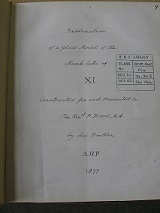
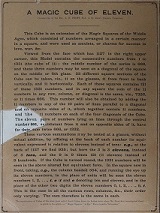
Frost's cube of eleven, Royal
Holloway University of London. (Photos by John Williamson in 2013-2014, click on the
images to enlarge them)
In the middle, the explanation sheet
is the first of 154 handwritten sheets describing the cube.
On the right,
a placard which has been kept alongside the cube
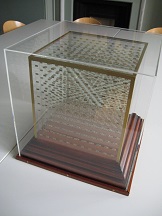
New photo of this cube by John Williamson in July 2015,
with his comments:
"The cube has now been conserved
and is in excellent condition. In order to protect it, it is now enclosed
in a perspex cover. I am sure it will be good for another 100 years.
The
cube is now held in the College archives along with other manuscripts and
documents of A H Frost which were donated to Holloway College by his daughter
Catherine Frost.
The cube and manuscripts are available to view on request
to the College Archivist"
- 1878-1882: Curate of Croxton, Lincolnshire. Writer of the long article on Magic
Squares for the 9th edition of the Encyclopaedia Britannica (1882) which was also
used in later
editions.

Beginning of the Frost's article in the Encyclopaedia
Britannica
(here the 11th edition, 1911)
- 1884-1902: Teacher of Marathi and Gujarati under the Board of Indian Civil Service
Studies. Gift received from W.A. Firth, author of a booklet of 19 pages, entitled
"The magic square" (Belfast, 1887), who dedicated to him a cube
of six, stored in a wooden box (1887). Publication of his article "On the construction of Nasik Squares
of any order" in the Proceedings of the London Mathematical Society
(1896). University teacher (from 1897). Death of his brother, Percival,
aged 81 (1898), who had written several mathematical books (A Treatise on Solid
Geometry, An Elementary Treatise on Curve Tracings,...) and who
edited Newton's Principia. Death of his second wife, Margaret,
aged 81 (1901).
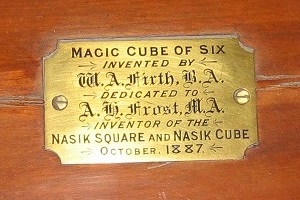
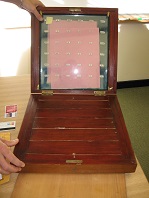
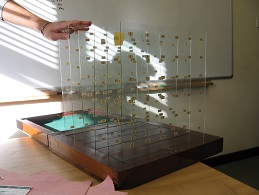
Wooden box storing Firth's cube of six dedicated to Frost,
Royal Holloway University of London. (Photos by John Williamson in 2013, click on the images to enlarge them)
The box is heavy and when opened up can be assembled to form the
cube. It opens flat and one half shows 6 strips of wood, the 6 vertical
planes of the cube.
- 1907: Died of heart failure in Cambridge, February 24th. Aged 88.
- 1933: His model of a magic cube of seven, kept at the South Kensington
Museum (now the Science Museum), deaccessioned and given to Prof. William P. Milne at Leeds University.
- 1951: His model of a magic cube of nine, kept in a wooden box at the St John's College Library, transferred and deposited on loan at the Whipple
Museum of the History of Science,
Cambridge, and is still there today.
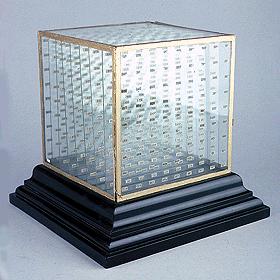
Frost's cube of nine, Whipple Museum of the History of
Science, Cambridge.
Length 289mm; breadth 286mm; height 270mm. Turned square
ebony base carries glass cube (edges covered with gold paper) which contains
7 glass plates. Each plate, together with the back and front of the cube carries
81 numbers, printed on paper, arranged in 9 rows of 9 columns. Each position
on the grid has two numbers, one facing in each direction. These numbers
run from 1 to 729.
- 1967: Death of Prof. William P. Milne who had the other Frost cube,
since 1933.
Where is this cube of seven, now? There is no trace of it at
the Library Museum of Leeds University. If you have any information about this
cube, send
me a message!

|
This biography of Andrew H. Frost has not been published before.
Many many thanks to:
- Fiona Colbert, Biographical Assistant, St
John's College, Cambridge
- Monica Elsey, Assistant Keeper of Collections, Whipple
Museum, Cambridge
- Jane Wess, Senior Curator, Astronomy and Mathematics
Collection, Science
Museum, London
- Adrian Whicher, Assistant Curator, Astronomy and
Mathematics Collection, Science
Museum, London
- Jayne Makepeace, Faculty Team Librarian, Chemistry
and Mathematics, Leeds
University Library, Leeds
- Martin Killeen, Reference Librarian, Special Collections,
University of
Birmingham, Main Library, Birmingham
- Ken Osborne, Archivist / Records Manager, Church
Mission Society, London
- Noel Flower, (on the children Percy H., Jane H.,
and Catherine) Cambridge, New Zealand
- John Williamson, (on the children Thomas and Horace,
on the cube of eleven and Firth's cube of six) Ascot, UK
for their kind and efficient help.
Christian Boyer.
|
Return to the home page http://www.multimagie.com
Andrew H. Frost (Hull 1819 - Cambridge 1907)




